Dual Band-Notched Rectangular Dielectric Resonator Antenna with Tunable Characteristic
Abstract
:1. Introduction
2. Antenna Design
2.1. Antenna Structure
2.2. Design Procedure
3. Results and Discussion
4. Conclusions
Author Contributions
Funding
Conflicts of Interest
References
- Long, S.A.; McAllister, M.W.; Shen, L.C. The resonant cylindrical dielectric cavity antenna. IEEE Trans. Antennas Propag. 1983, 31, 406–421. [Google Scholar] [CrossRef]
- Luk, K.M.; Leung, K.W. Dielectric Resonator Antennas; Studies Press Ltd.: Herfordshire, UK, 2003. [Google Scholar]
- Petosa, A. Dielectric Resonator Antenna Handbook; Artech House: Norwood, MA, USA, 2007. [Google Scholar]
- Petosa, A.; Ittipiboon, A. Dielectric resonator antennas: a historical review and the current state of the art. IEEE Antennas Propag. Mag. 2010, 52, 91–116. [Google Scholar] [CrossRef]
- Ryu, K.S.; Kishk, A.A. UWB dielectric resonator antenna having consistent Omnidirectional Pattern and low cross-polarization characteristics. IEEE Trans. Antennas Propag. 2011, 59, 1403–1408. [Google Scholar] [CrossRef]
- Ge, Y.; Esselle, K.P.; Bird, T.S. Compact dielectric resonator antennas with ultrawide 60%–110% bandwidth. IEEE Trans. Antennas Propag. 2011, 59, 3445–3448. [Google Scholar] [CrossRef]
- Bialkoski, M.E.; Abbosh, A.M. Design of UWB planar antenna with improved cut-off at the out-of-band frequencies. IEEE Antennas Wirel. Propag. Lett. 2008, 16, 408–410. [Google Scholar] [CrossRef]
- Deng, J.Y.; Hou, S.; Guo, L.X. Wideband-to narrowband tunable monopole antenna with integrated bandpass filters for UWB/WLAN applicaions. IEEE Antennas Wirel. Propag. Lett. 2017, 16, 2734–2737. [Google Scholar] [CrossRef]
- Zaker, R.; Ghobadi, C.; Nourinia, J. Bandwidth enhancement of novel compact single and dual band-notched printed monopole antenna with a pair of L-shaped slots. IEEE Trans. Antennas Propag. 2009, 57, 3978–3983. [Google Scholar] [CrossRef]
- Chen, B.; Leung, W.; Wang, A.G.; Zhao, G.H. Compact ultra-wideband antenna with reconfigurable notched bands. Electron. Lett. 2012, 48, 1175–1179. [Google Scholar] [CrossRef]
- Horestani, A.K.; Shaterian, Z.; Naqui, J.; Martin, F.; Fumeaux, C. Reconfigurable and tunable S-shaped split-ring resonators and application in band-notched UWB antennas. IEEE Trans. Antennas Propag. 2016, 64, 3766–3779. [Google Scholar] [CrossRef]
- Vendik, I.B.; Rusakov, A.; Kanjanasit, K.; Hong, J.; Filonov, D. Ultrawideband (UWB) planar antenna with single-, dual-, and triple-band notched characteristic based on electric ring resonator. IEEE Antennas Wirel. Propag. Lett. 2017, 16, 1597–1600. [Google Scholar] [CrossRef]
- Niroo-Jazi, M.; Denidni, T.A. Experimental investiagtions of a novel ultrawideband dielectric resonator antenna with rejection band using hybrid techniques. IEEE Antennas Wirel. Propag. Lett. 2012, 11, 492–495. [Google Scholar] [CrossRef]
- Abedian, M.; Rahim, S.K.A.; Danesh, S.; Khalily, M.; Noghabaei, S.M. Ultrawideband dielectric resonator antenna with WLAN band rejection at 5.8 GHz. IEEE Antennas Wirel. Propag. Lett. 2013, 12, 1523–1526. [Google Scholar] [CrossRef]
- Abedian, M.; Rahim, S.K.A.; Danesh, S.; Hakimi, S.; Cheong, L.Y.; Jamaluddin, M.H. Novel design of compact UWB dielectric resonator antenna with dual-band-rejection characteristics for WiMAX/WLAN bands. IEEE Antennas Wirel. Propag. Lett. 2015, 14, 245–248. [Google Scholar] [CrossRef]
- Wang, Y.F.; Denidni, T.A.; Zeng, Q.S.; Wei, G. Band-notched UWB rectangular dielectric resonator antenna. Electon. Lett. 2014, 50, 483–484. [Google Scholar] [CrossRef]
- Denidni, T.A.; Weng, Z. Hybrid ultrawideband dielectric resonator antenna and band-notched designs. IET Microwaves Antennas Propag. 2011, 5, 450–458. [Google Scholar] [CrossRef]
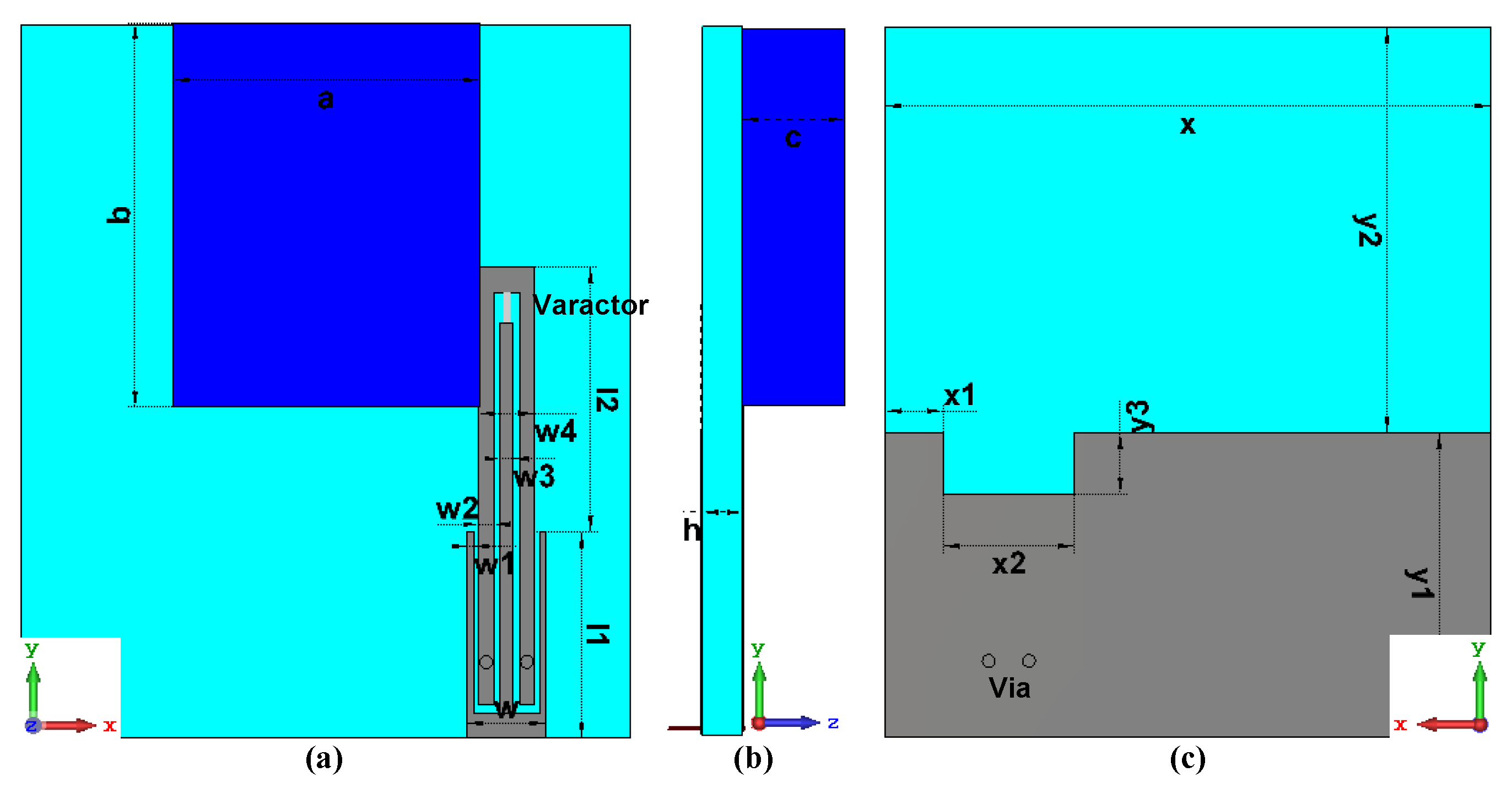
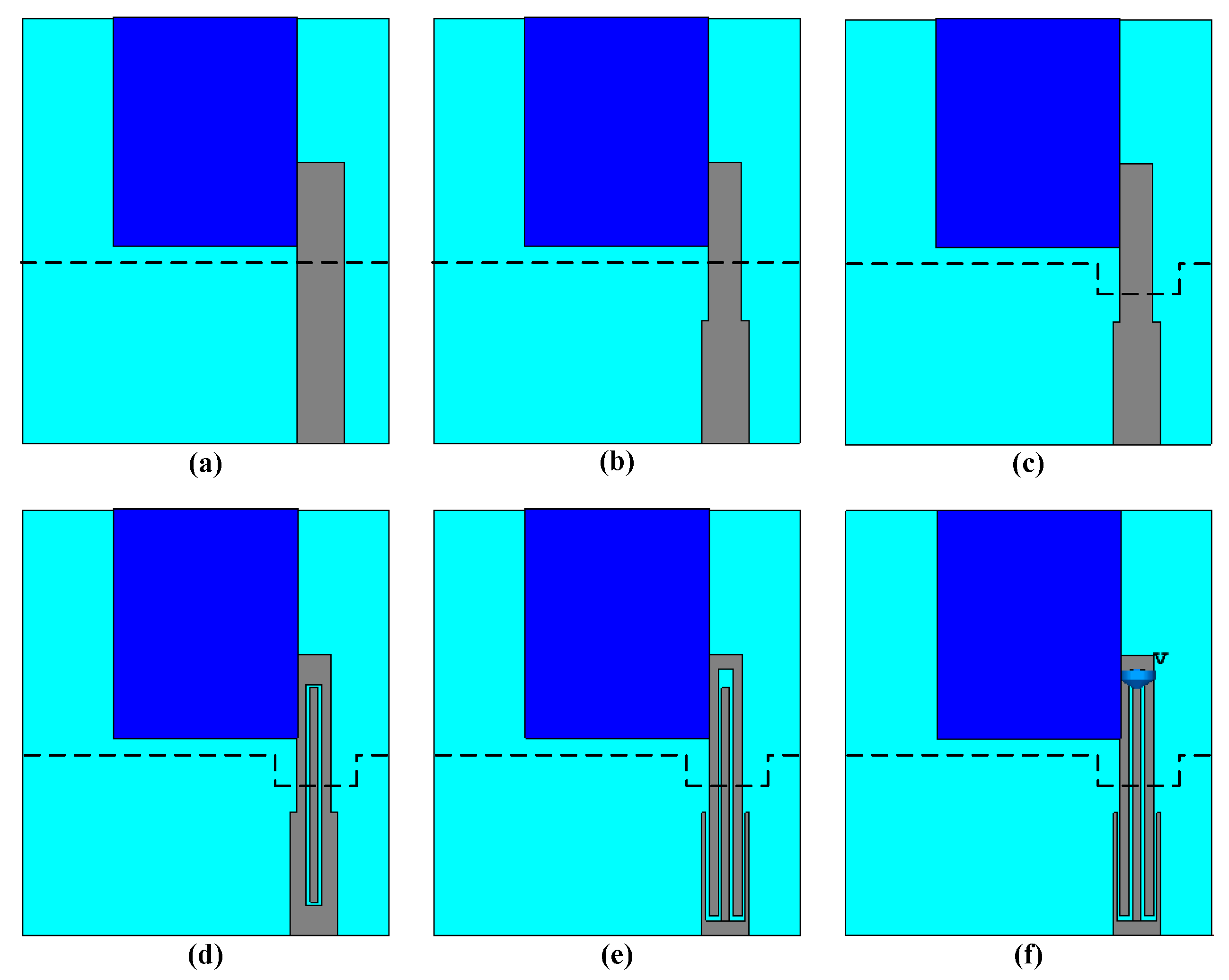
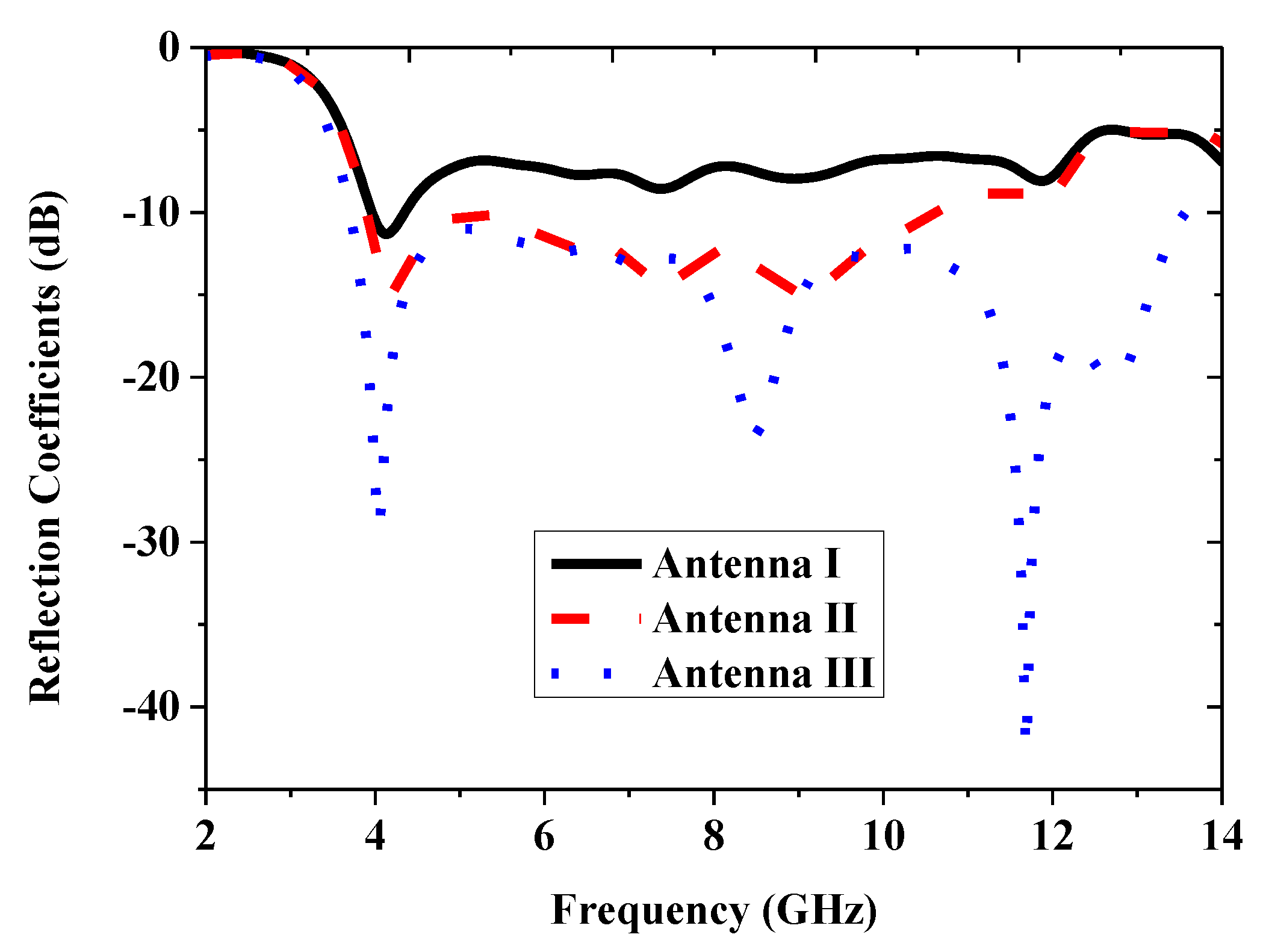
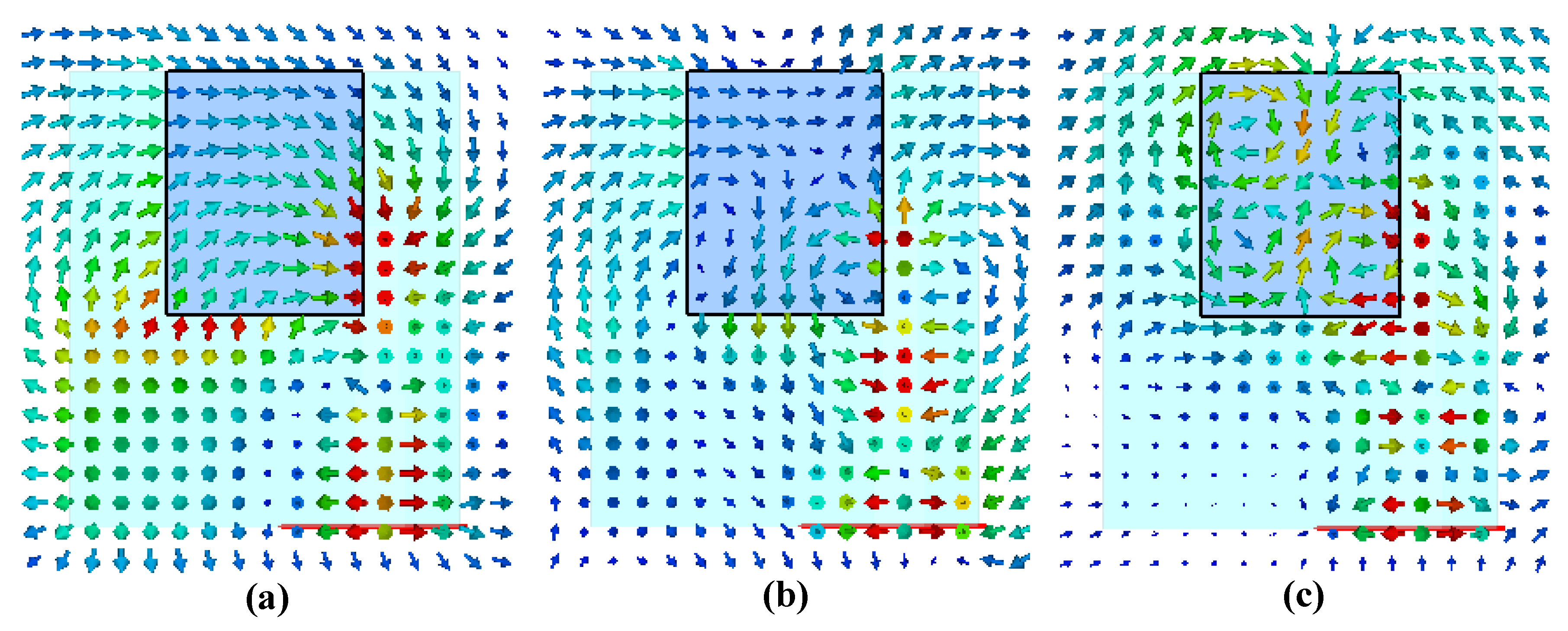
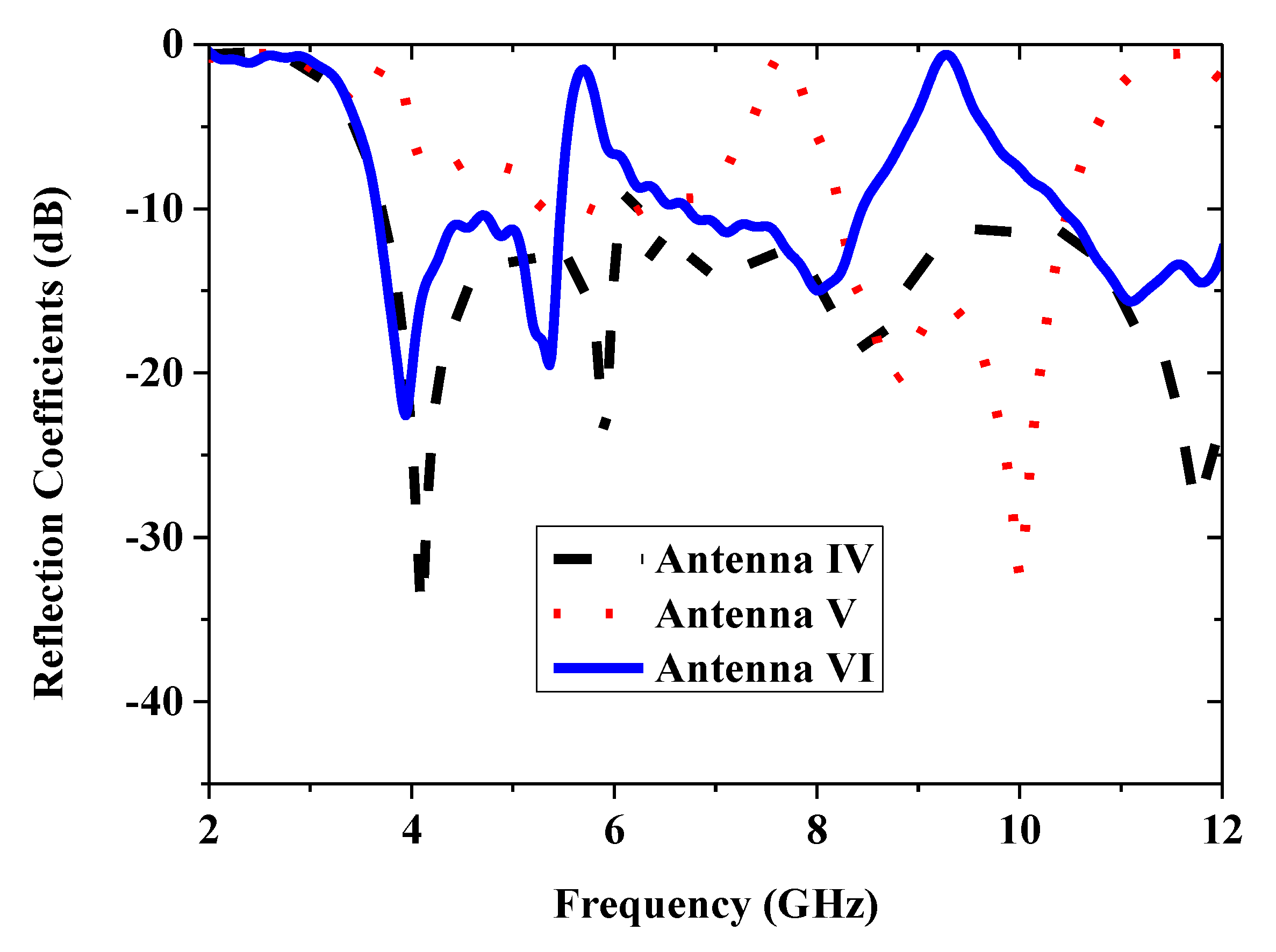
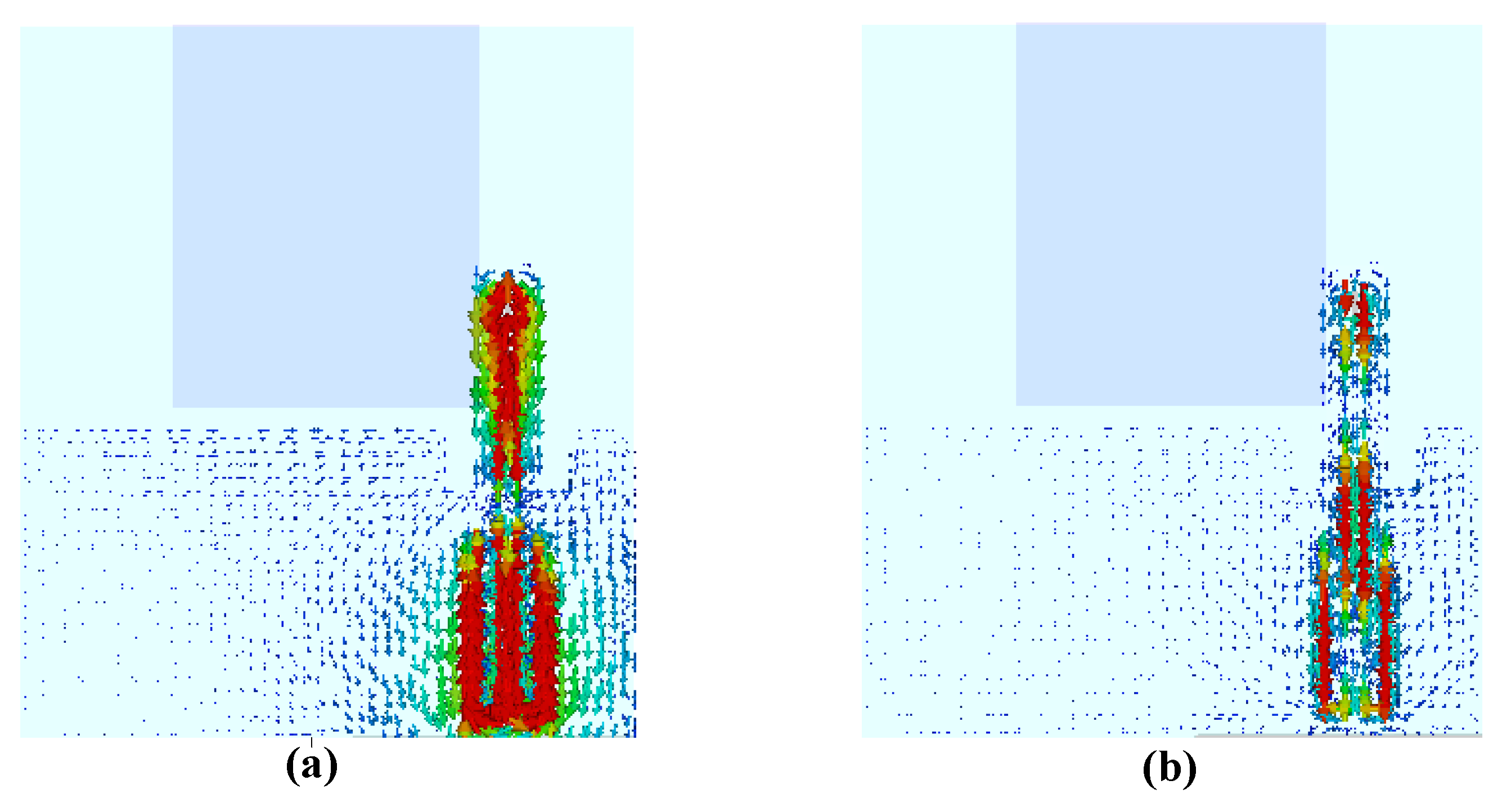
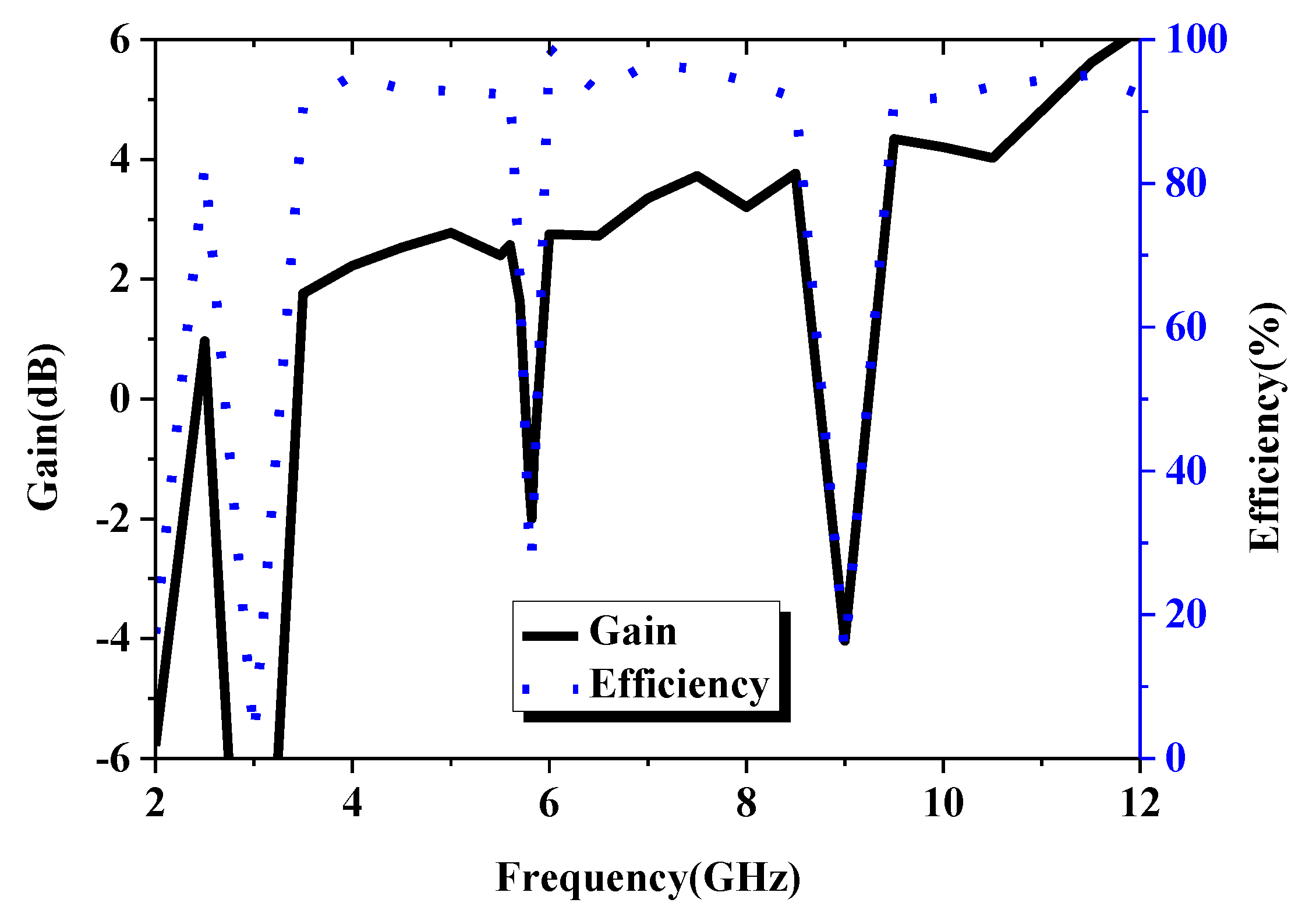


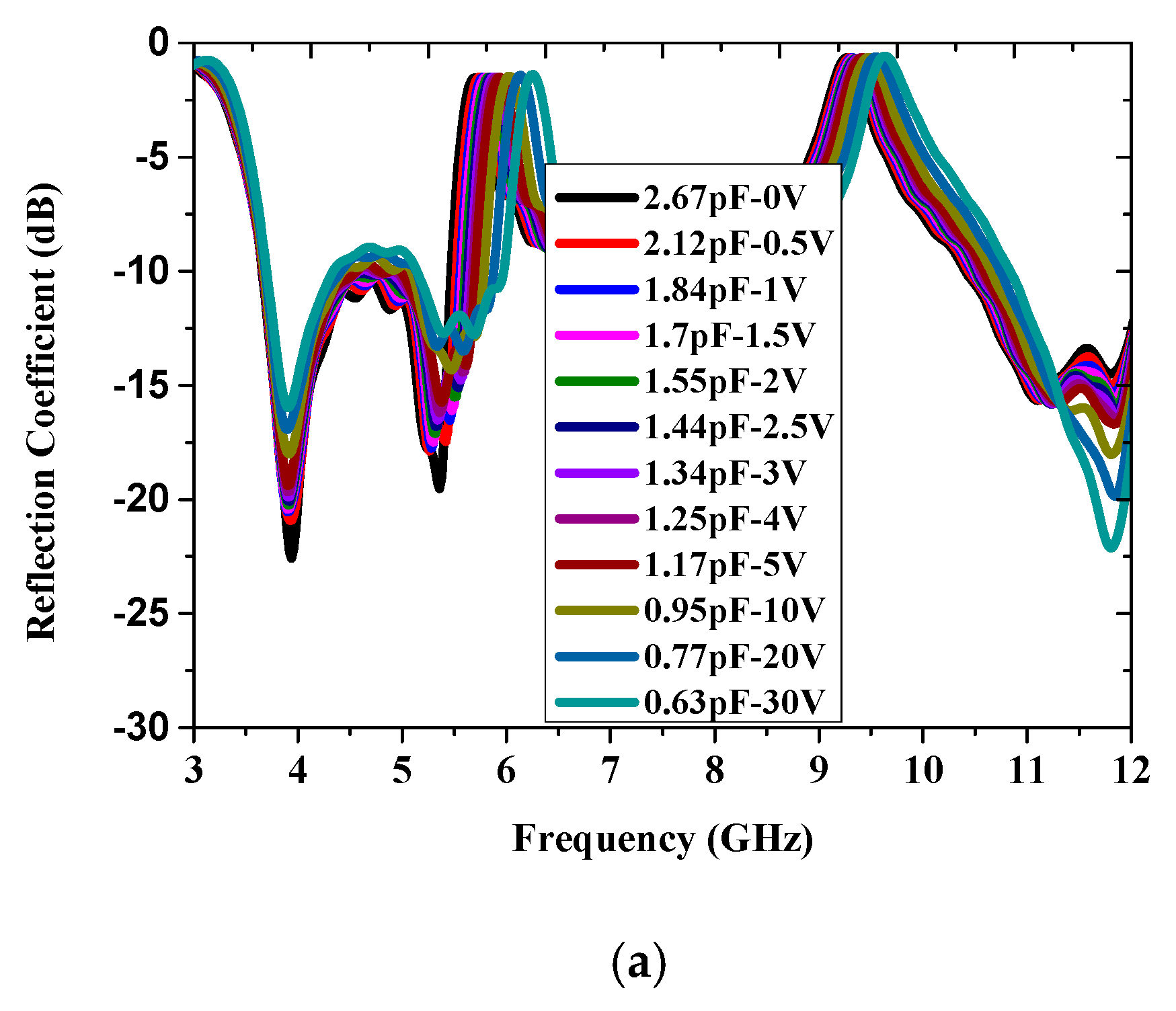

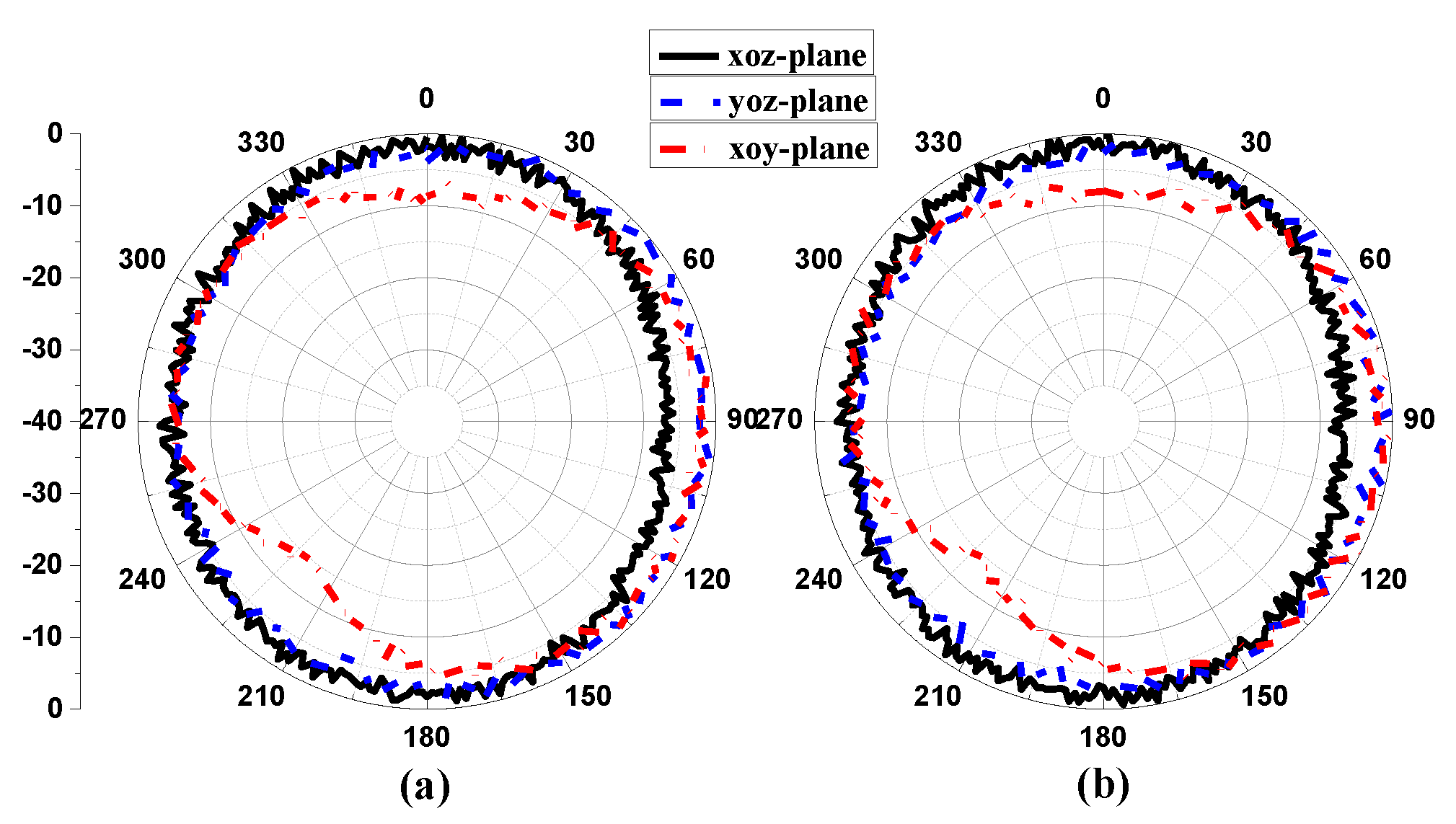
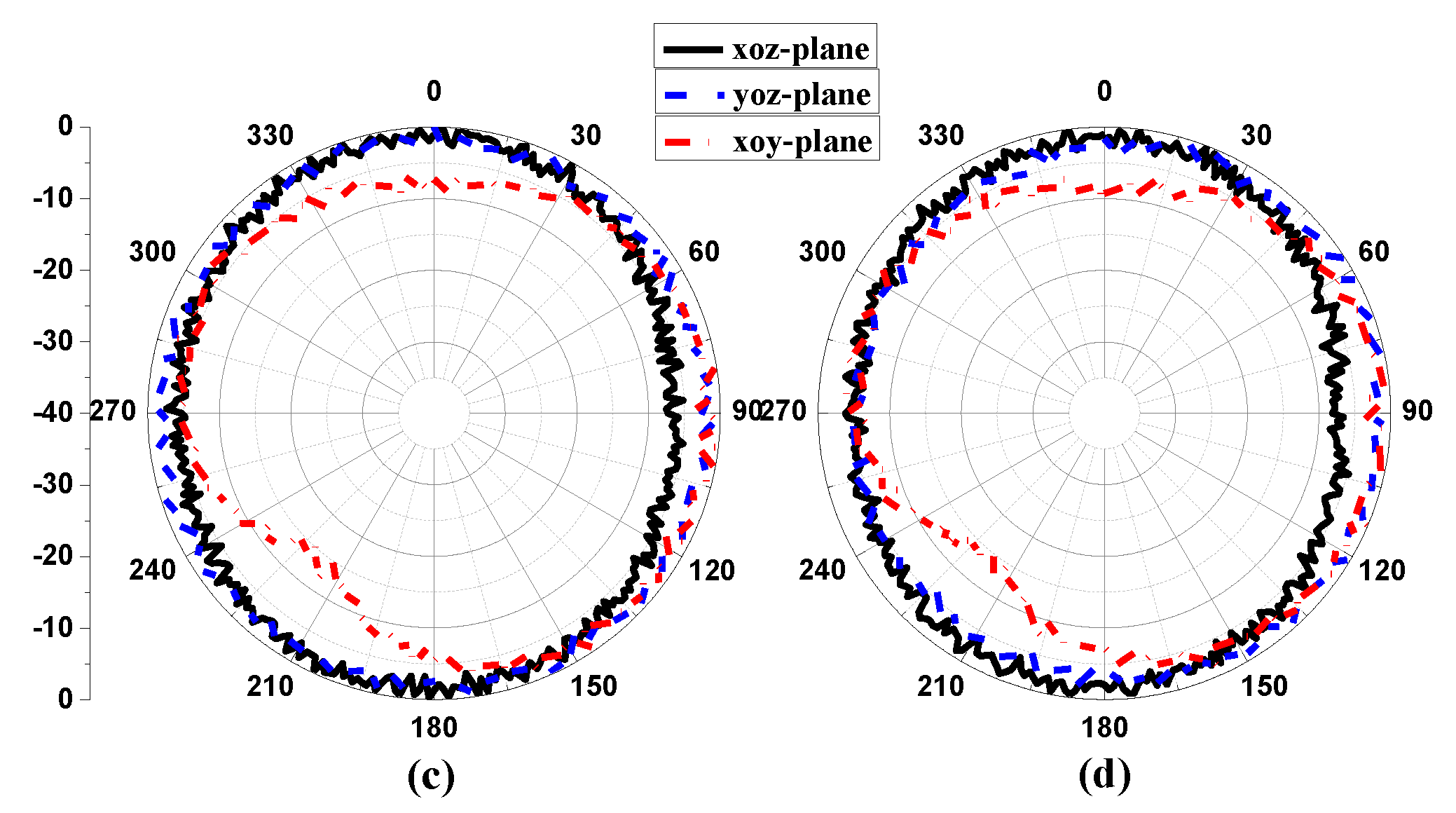
| Vr (V) | 0 | 0.5 | 1.0 | 1.5 | 2.0 | 2.5 |
| Cj (pF) | 2.67 | 2.12 | 1.84 | 1.70 | 1.55 | 1.44 |
| Vr (V) | 3.0 | 4.0 | 5.0 | 10.0 | 20.0 | 30.0 |
| Cj (pF) | 1.34 | 1.25 | 1.17 | 0.95 | 0.77 | 0.63 |
| Parameters | a | b | c | h | l1 | l2 |
| Value (mm) | 12 | 15 | 4 | 1.6 | 8.1 | 10.4 |
| Parameters | w1 | w2 | w3 | w4 | w | x |
| Value (mm) | 0.3 | 0.6 | 0.5 | 2.2 | 3.1 | 24 |
| Parameters | x1 | x2 | y1 | y2 | y3 | εr |
| Value (mm) | 2.3 | 5.2 | 12 | 16 | 2.4 | 9.9 |
| Ref. | Feed Technique | Wideband Range (GHz) | Notched-Band Range (GHz) | Notched-Band No. | Tunable Characteristic |
|---|---|---|---|---|---|
| [13] | Probe | 2–10.7 | 5.15–5.828 | 1 | No |
| [14] | Microstrip | 3.05–12.1 | 5.71–6.32 | 1 | No |
| [15] | Microstrip | 3.03–12.52 | 3.22–4.06 4.84–5.96 | 2 | No |
| [16] | Probe + Patch | 3.6–12 | 5.1–6 | 1 | No |
| [17] | Coplanar Waveguide | 3.1–10.6 | 3.35–3.8 5.1–6.1 | 2 | No |
| Our work | Microstrip | 3.71–11.27 | 5.3–5.84 8.74–8.98 | 2 | Yes |
© 2019 by the authors. Licensee MDPI, Basel, Switzerland. This article is an open access article distributed under the terms and conditions of the Creative Commons Attribution (CC BY) license (http://creativecommons.org/licenses/by/4.0/).
Share and Cite
Liu, B.; Qiu, J.; Chen, L.; Li, G. Dual Band-Notched Rectangular Dielectric Resonator Antenna with Tunable Characteristic. Electronics 2019, 8, 472. https://doi.org/10.3390/electronics8050472
Liu B, Qiu J, Chen L, Li G. Dual Band-Notched Rectangular Dielectric Resonator Antenna with Tunable Characteristic. Electronics. 2019; 8(5):472. https://doi.org/10.3390/electronics8050472
Chicago/Turabian StyleLiu, Beijia, Jinghui Qiu, Lijia Chen, and Guoqiang Li. 2019. "Dual Band-Notched Rectangular Dielectric Resonator Antenna with Tunable Characteristic" Electronics 8, no. 5: 472. https://doi.org/10.3390/electronics8050472
APA StyleLiu, B., Qiu, J., Chen, L., & Li, G. (2019). Dual Band-Notched Rectangular Dielectric Resonator Antenna with Tunable Characteristic. Electronics, 8(5), 472. https://doi.org/10.3390/electronics8050472





